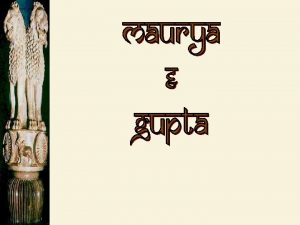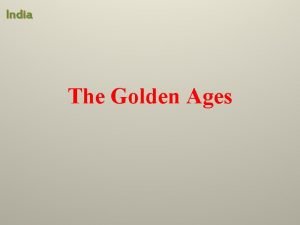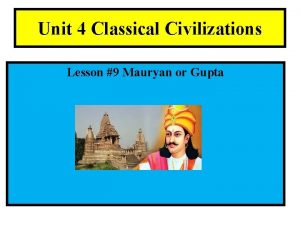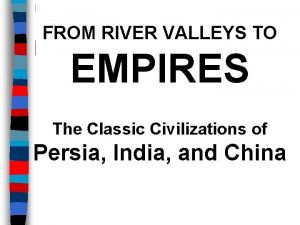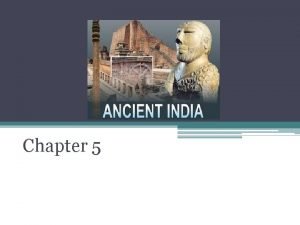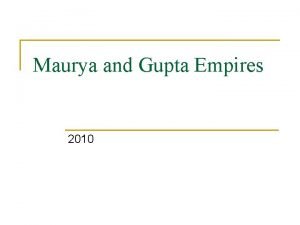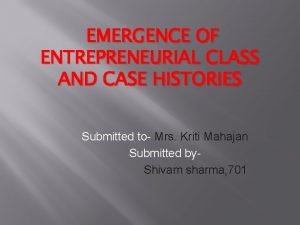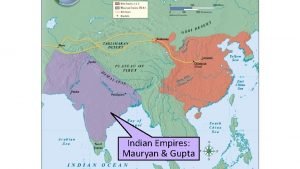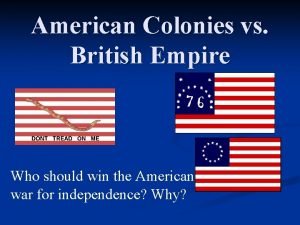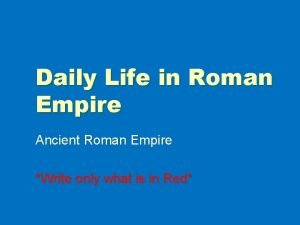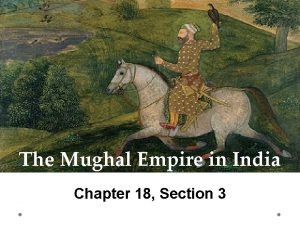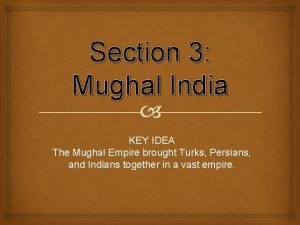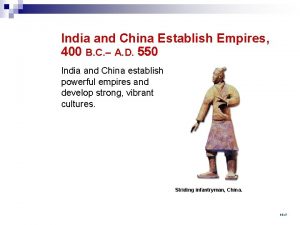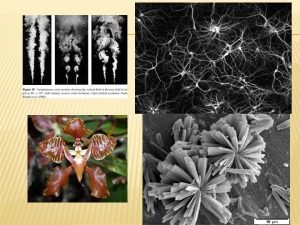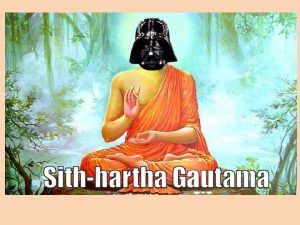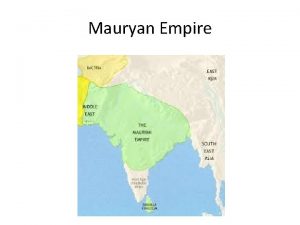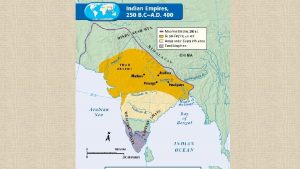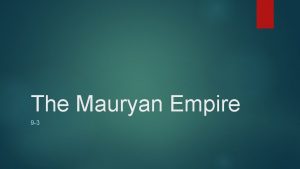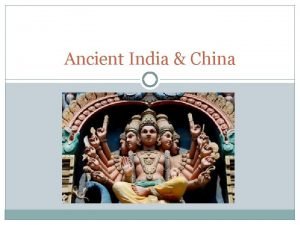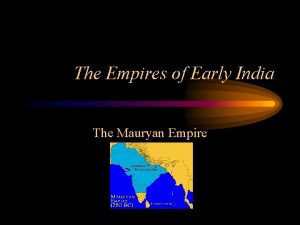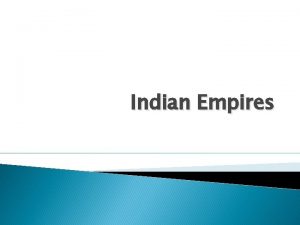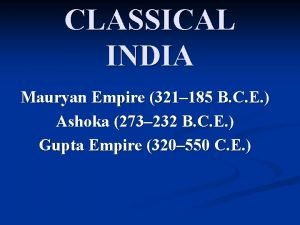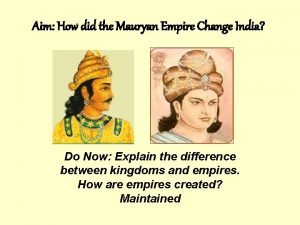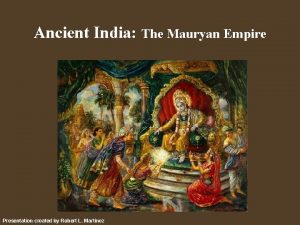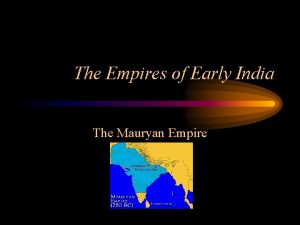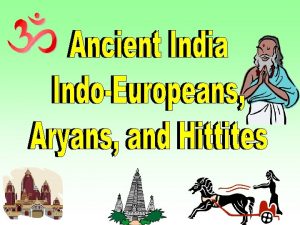Ch 4 Emergence of Empire Mauryan India 1















- Slides: 15

Ch. 4 Emergence of Empire: Mauryan India 1. Chandragupta 2. Asoka 3. Administration 4. Religion 5. Society

Introduction • • • First unified empire in India Numerous sources of information Literature: Megasthenes’ Indica Kautilya’s Arthasastra Numerous Buddhist texts Numerous inscriptions of Asoka

Chandra Gupta • The origin of Chandragupta or Maurya clan are not clearly known. • As a child he was brought up by his mother • He was discovered in the forests by Chanakya- author of Arthasastra (the first political compendium of India) • He gathered forces around him from the tribal republics at the borders

His conquests • Succeeded in 321 B. C. E- to establish his own empire • His conquests began from borderlands- did not directly attack the Nanda empire • He defeated the Greek Garrison in the North West- the treaty included his marriage to Selucus’s daughter and the territories in the North West (Afghanisthan) • Exchange of Envoys: Megasthenes lived for many years in Pataliputra- Mauryan capital

Bindusara • Towards the end of his life, he is converted to Jainism and performed the Jain Sullekhana (starvation to death) • Bindusara succeded in 297 B. C. E • Also known as Amitraghata (Gk. Amitrochates • Diplomatic relations with Antiochus I • Campaigns in South India

Asoka 272 B. C. E • Asoka conquered the only territory that was not included in the empire- Kalinga • He issued numerous rock edicts placed in various placed in his kingdom • Written in Brahmi script- deciphered by James Princep in 1837 • Converted to Buddhism • 3 rd Buddhist council held at Pataliputra • Buddhist missions to various countries • Greeks, southeast Asia, Tibet • Srilanka- sent his deughter and son as Buddhist missionaries

• It is Asoka’s personal involvement with Buddhism that inspired him towards the welfare state ideal and humanistic rule which was emulated by later rulers. Asoka is remembered for his righteous rule. • Buddhism in South and Southeast Asia owes its origin to Asoka. Theravada Buddhist countries such as Srilanka and other Southeast Asian countries received Theravada Buddhism due to the enthusiastic support of Asoka for the Buddhist Sangha. 12/22/2021 7

Asoka and Personal practice & Buddhist Sangha • • 12/22/2021 Scripture Pilgrimage Construction of stupas Sangha Purification of Sangha Third Buddhist Council Missionaries 8


Administration • Agrarian economy- taxation of village resources was the primary source of income for the empire • Clearing the forests for cultivation: war captives were used • Ownership of land- individuals and king • Irrigation- Girnar- water reservoir was constructed to provide water for irrigation

• Guilds: crafts and artisans • Localization and hereditary nature of occupations • Several occupations listed in taxation records: Weaving, liquor, slaughterhouses, ships, cows, goldsmiths, forest produce • Large standing army • Technically four castes- but numerous castes groups are known • Megasthenes- classes them as 7 castes • Philosophers, farmers, soldiers, herdsmen, artisans, magistrates and councillors.

• Centralized bureaucracy- king traveled extensively in the kingdom- in touch with people and local officials • A clear administration for the first time • Treasurer and Chief Collector controlled the revenue from the center • Salaries for officials- not land grants • State maintained public works: roads, irrigation canals, mining, rest houses

• Kingdom is divided into 4 provincesdirectly governed by the princes of the Royal family. • Punishment with fines- but capital punishment known from this period • Asoka’s dharma- proclamations- on how one should conduct oneself

Demise of the empire • Asoka died 232 B. C. E. • North west Bactrian Greeks- also known as Indo-Greeks by 180 B. C. E • The first experiment with centralized empire has ended- Do you think it really ended- or do you see any unity continue in Indian civilization?

Further Questions • Scholarly views on Asoka • What happened to Buddhism, his policies, welfare state after Asoka? What is his legacy? • Did India stay united or split up into smaller states? • What was the status of women? • Other religions of this period. • Indo-Greek relations. • Internal polity and other foreign relations. 12/22/2021 15
 Mauryan empire and gupta empire venn diagram
Mauryan empire and gupta empire venn diagram Why mauryan empire decline
Why mauryan empire decline Mauryan empire
Mauryan empire How did the mauryan empire’s army help to promote trade?
How did the mauryan empire’s army help to promote trade? The mauryan empire
The mauryan empire Harappan civilization
Harappan civilization Mauryan and gupta empire map
Mauryan and gupta empire map Emergence of entrepreneurial class in india
Emergence of entrepreneurial class in india Mauryan people
Mauryan people American empire vs british empire
American empire vs british empire Rich and poor romans
Rich and poor romans Chapter 7 section 1 india's first empires
Chapter 7 section 1 india's first empires Chapter 18 section 3 the mughal empire in india
Chapter 18 section 3 the mughal empire in india The mughal empire in india chapter 18 section 3
The mughal empire in india chapter 18 section 3 Largest empire in india
Largest empire in india Emergence theory
Emergence theory
